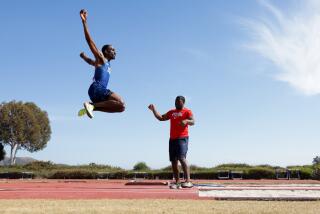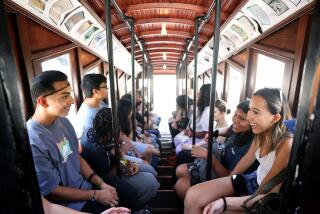Students Put Themselves in Place of Disabled
LONG BEACH — Susan Kaibney was not able to dance at her high school homecoming.
Leanne Lindner was worried about the logistics of using the restroom.
And Dana Block feared collisions with fast-moving pedestrians at California State University, Long Beach, where all three are students.
“I feel insecure,” said Block, 20, a physical therapy major. “I don’t know what’s going on behind me or to my sides.”
Block was wearing goggles that eliminated her peripheral vision as part of a seven-day exercise involving nearly 50 students. In the same exercise, Kaibney, 18, was fitted with a leg brace and crutches, while Lindner, 21, went around with one hand immobilized by a glove without fingers.
The purpose “is to make people more sensitive to the lives of handicapped people,” said Cathy Shimozono, coordinator of the exercise.
“This is tremendous,” said David Sanfilippo, staff director of disabled student services. “We’ve put people in wheelchairs for an hour or two, but never anything like this.”
The project, called Give-a-Care, is the brainchild of Shimozono, a 40-year-old English major who has spent 17 1/2 years in a wheelchair because of a spinal lesion of unknown cause. “Too many times I go to cross the street and can’t get down the ramp because someone is blocking it,” she said. “Or go to park and can’t because someone is using the space. People just don’t care.”
Shimozono placed ads in the campus newspaper seeking volunteers to live the lives of the disabled. They were asked to fill out questionnaires, which Shimozono used to assign disabilities. Although volunteers were not allowed to choose their disabilities, Shimozono said care was taken not to put students in jeopardy.
Besides leg braces, hand socks and goggles that simulate three types of blindness, volunteers were put in wheelchairs, fitted with back braces and arm slings or given headsets to simulate degrees of deafness.
The rules were simple. Using the honor system, the students, some of whom are getting class credit for their involvement, kept their disabilities for seven days.
Before-and-after questionnaires, as well as journals kept by the students during the week, will be used to train staff members and teach courses on the psychology of disability, Sanfilippo said.
There was an apprehensive mood at the first meeting as participants waited to find out what disability they would get.
“I’m terrified to death of this,” said Chris Ryan, a 26-year-old finance major, after learning that he would be confined to a wheelchair. “I’ll have to learn where all the ramps are. It will be very uncomfortable.”
Lani Nothwang, 22, said her class on the problems of the disabled prompted her to take part in the experiment. Having been issued a headset that simulated deafness, she said she would work out a system of blinking lights to communicate at home with her mother.
By the end of the first day, many participants had devised ways of coping with their disabilities and in some cases seemed to be enjoying them.
“It’s been fun so far,” said Jane Weed, 22, sitting in her wheelchair at a bus stop next to the bicycle she had ridden to school that morning. “Tomorrow I’ll take Dial-a-Ride.”
And Kaibney, hobbling down a hallway in her leg brace, was already thinking of ways to play her disability to best advantage. “I’m going to get a lot of cute guys to help me upstairs,” she said.
Shimozono says she has heard all that before and is not bothered by it. “For the first day or two, people are going to have a lot of fun,” she said. “Then, they’re going to find out what it’s like having a disability.”
More to Read
Sign up for Essential California
The most important California stories and recommendations in your inbox every morning.
You may occasionally receive promotional content from the Los Angeles Times.










